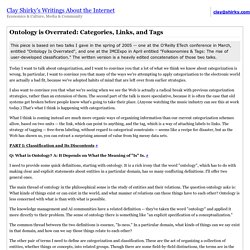

Ontology (information science) In computer science and information science, an ontology formally represents knowledge as a hierarchy of concepts within a domain, using a shared vocabulary to denote the types, properties and interrelationships of those concepts.[1][2] Ontologies are the structural frameworks for organizing information and are used in artificial intelligence, the Semantic Web, systems engineering, software engineering, biomedical informatics, library science, enterprise bookmarking, and information architecture as a form of knowledge representation about the world or some part of it.
The creation of domain ontologies is also fundamental to the definition and use of an enterprise architecture framework. The term ontology has its origin in philosophy and has been applied in many different ways. The word element onto- comes from the Greek ὤν, ὄντος, ("being", "that which is"), present participle of the verb εἰμί ("be").
According to Gruber (1993): As We May Think. As We May Think (deutsch Wie wir denken werden) ist ein Essay des amerikanischen Ingenieurs Vannevar Bush, der 1945 in der Zeitschrift Atlantic Monthly publiziert wurde.

Bush entwirft darin das Konzept der universalen Wissensmaschine Memex (Abkürzung für Memory Extender), die als Vorläufer von Personal Computer und Hypertext gilt. Parallel mit As We May Think veröffentlichte Bush einen Bericht an den amerikanischen Präsidenten („Science – The Endless Frontier“), der die staatlich geförderte Vernetzung von Wissenschaft, Industrie und Militär empfiehlt. Entstehungs- und Wirkungsgeschichte[Bearbeiten] Bush hat das Memex-Konzept erstmals im Jahr 1939 skizziert.
Ein 1941 entstandenes Memorandum regarding Memex wurde schließlich zum im Juli 1945 publizierten Essay As We May Think erweitert. Viele Computer-Pioniere sahen rückblickend in Bushs Memex-Konzept den Ausgangspunkt der intuitiven Interaktion zwischen Mensch und (Rechen-)Maschine. Inhalt[Bearbeiten] Literatur[Bearbeiten] The Pattern which Connects from KaliYuga to Tao: Complexity of Tao. The definition of complexity of a system is itself complex: several authors in different historical periods in different disciplines have used different definitions.

Seth Lloyd ranked in the first 90s at least 32 examples of definitions, including information (Shannon), entropy (Gibbs-Boltzmann), algorithmic complexity, self-delimiting code length, minimum length description, number of parameters, the degrees of freedom or dimensions, mutual information or channel capacity, correlation, fractal dimension, self-similarity, sophistication, size of the machine topology, difference in a subtree graph, temporal or spatial complexity of calculation, logic depth or thermodynamics, arge-scale order, self-organization, edge of chaos and others. Generally, complex systems may have the following features:Very large number of elements and connections Difficult to determine boundaries It can be difficult to determine the boundaries of a complex system.
May be open May have a memory. Metadata Principles and Practicalities. I.

Introduction The rapid changes in the means of information access occasioned by the emergence of the World Wide Web have spawned an upheaval in the means of describing and managing information resources. Metadata is a primary tool in this work, and an important link in the value chain of knowledge economies. Yet there is much confusion about how metadata should be integrated into information systems. How is it to be created or extended? The authors hope to make explicit the strong foundations of agreement shared by two prominent metadata Initiatives: the Dublin Core Metadata Initiative (DCMI) and the Institute for Electrical and Electronics Engineers (IEEE) Learning Object Metadata (LOM) Working Group.
The ideas in this paper are divided into two categories. II. A. Metadata modularity is a key organizing principle for environments characterized by vastly diverse sources of content, styles of content management, and approaches to resource description. B. C. Ontology creation for the rest of us… COE is a project whose goal is to develop an integrated suite of software tools for constructing, sharing and viewing OWL encoded ontologies based on CmapTools, a concept mapping software used in educational settings, training, and knowledge capturing.

Concept maps provide a human-centered interface to display the structure, content, and scope of an ontology. Currently, our work focuses on developing conventions for constructing new Cmap OWL ontologies that will assist and guide users when forming class and property relationships among the concepts in the ontology. In addition, we are working on clustering and searching techniques that support the reuse of existing ontologies. An overview presentation is here. Startup instructions are here. The manual is here. Papers OWL Templates People Adding IHMC Public Ontologies Download Updater for V5.0.3. Categories, Links, and Tags. Ontology is Overrated: Categories, Links, and Tags This piece is based on two talks I gave in the spring of 2005 -- one at the O'Reilly ETech conference in March, entitled "Ontology Is Overrated", and one at the IMCExpo in April entitled "Folksonomies & Tags: The rise of user-developed classification.

" The written version is a heavily edited concatenation of those two talks. Today I want to talk about categorization, and I want to convince you that a lot of what we think we know about categorization is wrong. In particular, I want to convince you that many of the ways we're attempting to apply categorization to the electronic world are actually a bad fit, because we've adopted habits of mind that are left over from earlier strategies. I also want to convince you that what we're seeing when we see the Web is actually a radical break with previous categorization strategies, rather than an extension of them. PART I: Classification and Its Discontents #